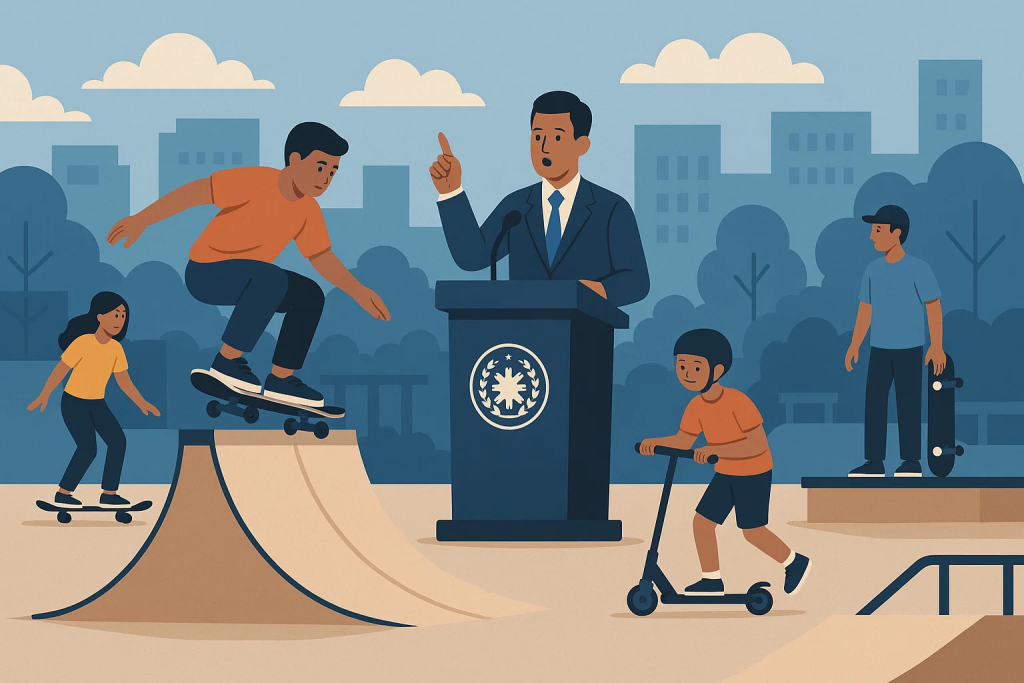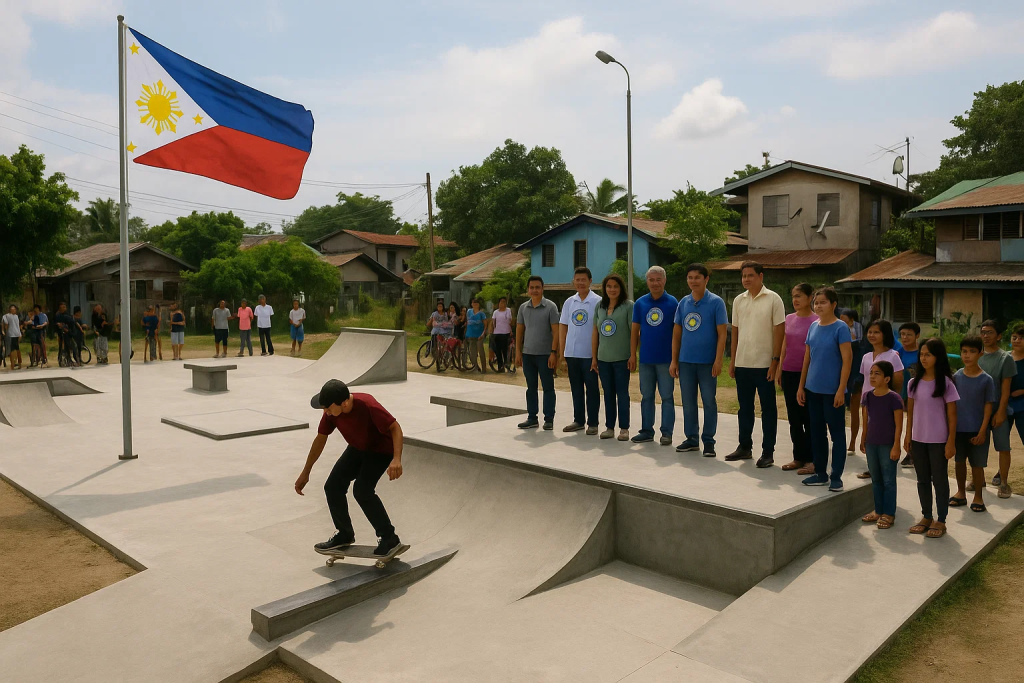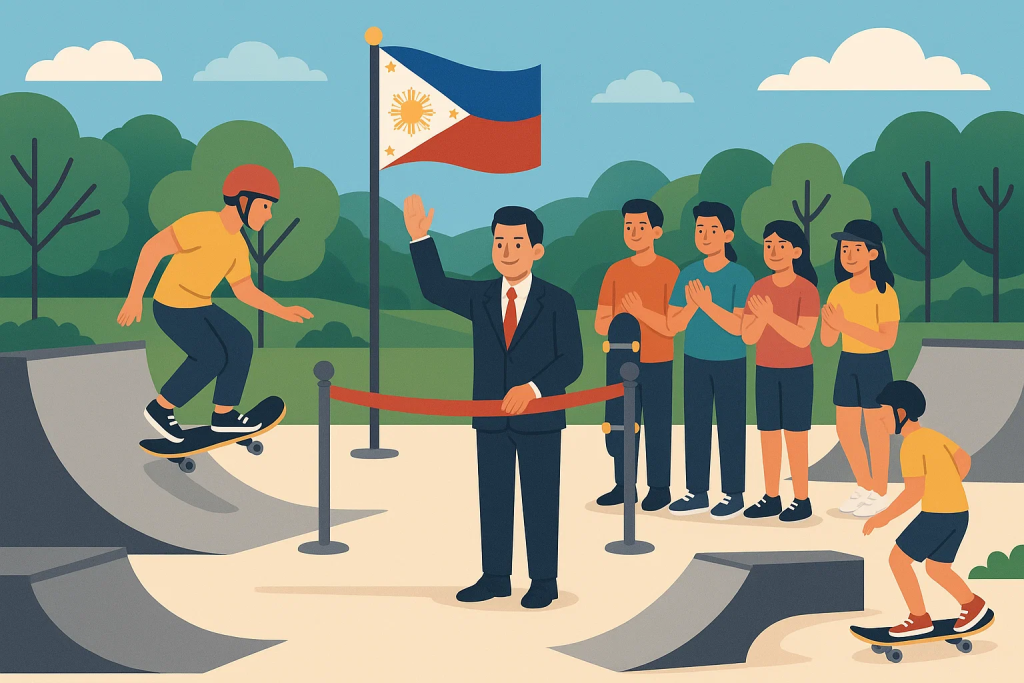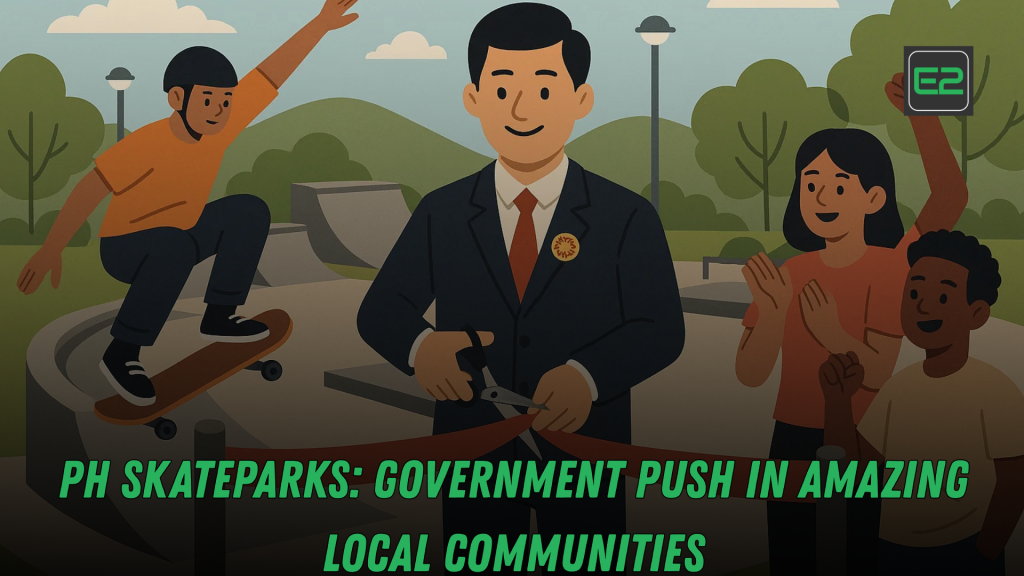Table of Contents
TL;DR (What You’ll Get From This Guide)
This 3,000-word playbook shows how government-backed skateparks are emerging across the Philippines and how LGUs, NGOs, and local crews can plan, fund, build, program, and sustain skate spaces that genuinely work for communities. You’ll learn:
- Where public skateparks are being planned or opened (QC Memorial Circle, Danao City, Cebu discussions) and what that means for your locality.
- Why community co-design beats top-down builds—plus a simple requirements brief LGUs can adopt.
- Funding mix and maintenance models that keep parks alive, and pitfalls to avoid (including demolition/closures risk).
- A practical 12-step roadmap for barangays and cities, with a plug-and-play RFP/BOQ checklist based on real procurement docs.
Bookmark it, share it with your councilor or mayor’s office, and use the templates at the end to speed up action.

Why Skateparks, Why Now?
Skateboarding is one of the lowest-cost, highest-impact youth sports: a skateboard, griptape, and a safe place to roll. A good skatepark acts like a third place—free, inclusive, and self-governing. In the PH, momentum is rising thanks to:
- Public demand & Olympic visibility. The Philippines’ own Margielyn Didal helped elevate the sport; her success kept pressure on cities like Cebu to deliver on promised parks.
- City-led placemaking. Projects like Circuit City Skate Park (Makati) show how a properly designed skate facility can activate underused land and connect with youth culture. (Private-led but offers design lessons for LGUs.)
- Formal programs in LGUs. Quezon City has publicly posted procurement for a QC Memorial Circle skatepark as part of its broader redevelopment—clear evidence that parks are entering official pipelines.
- Regional openings. Danao City announced a municipal skatepark to engage Visayas youth—an LGU case study in framing skateparks as youth development assets.
At the same time, communities have seen how poor planning can backfire: the closure/demolition of Manila Skate Park sparked public outcry and highlighted the need for binding safeguards in planning, tenure, and maintenance.
The Skateparks Policy Case for LGUs: Health, Safety, Tourism, and Social ROI
- Health & safety: Skateparks move skating off busy streets into a designed, safer space. They reduce nuisance complaints by channeling energy to a sanctioned venue with lighting and sightlines.
- Youth & inclusion: Skateboarding is gender-inclusive and skill-agnostic. With free lessons and adaptive features, parks become gateway spaces for girls, LGBTQ+, differently abled skaters, and beginners. Programs like those run via Make Life Skate Life show the power of community-led classes to build confidence.
- Micro-tourism & creative economy: Skate events bring foot traffic to local eateries, barbershops, and small businesses; film and photo crews produce earned media for the city.
- Urban revitalization: Underused corners, flood-prone lots (with proper drainage), or edges of large parks become 24/7-activated zones when skating, BMX, scoot, and inline share a well-lit plaza.
Skateparks Design That Works: From Plaza Vibes to Beginner Zones
1) Set the Brief (Not the Shape)
Cities should write performance briefs that define outcomes (flow, learnability, all-levels access) rather than dictating obstacles. Use the brief to require community co-design (workshops with local skaters, coaches, nearby residents, PWD groups). This is how Circuit City achieved authenticity.
Minimum brief items:
- Zones by skill: Beginner pad with mellow banks/curbs; intermediate lines; advanced features (e.g., hips, rails, manual pads, small bowl).
- Sightlines & CPTED: Clear visibility from the street, no blind pockets, good lighting, passive surveillance.
- Drainage & surfacing: Crown and slot drains; broomed concrete with trowel finish on lips; expansion joints and rebar spec.
- Shade & rest: Trees, tensile shade, water fountain/bottle refilling, benches away from fall zones.
- Multi-use tolerance: Scoot/inline/BMX allowed in designated hours; signage sets etiquette.
- Accessibility: ADA-like gradient paths, beginner-friendly roll-ins, tactile edges for PWD.
2) Size and Program
- Barangay starter (300–600 m²): Flatground pad, two lines, micro-quarter, bank-to-funbox, curbs/ledges.
- District park (800–1,500 m²): Bowl pocket + street plaza, three lines, event viewing edges, storage room.
- City hub (2,000+ m²): Street and bowl sections, comp-grade lighting, bleachers, toilets, first-aid kiosk, staff bay.
3) Skateparks Materials & Specs (BOQ-Style Cheatsheet)
When you move to bidding, require a Bill of Quantities (BOQ) with: structural excavation, gravel fill, moisture protection, concrete finishing, formwork, rebar schedule, and OSH items—mirroring how QC posts its public works BOQs.
Concrete: 28–32 MPa compressive strength, 125–150 mm slump, steel trowel + light broom.
Rails/edges: Hot-dip galvanized steel; granite for ledge copings (durable, skateable).
Lighting: Uniform >20 lux average, glare-controlled, timers until 10–11 PM.
Drainage: ≥1% crossfall, trench drains at low points, run-off not directed to neighbors.
Skateparks Community Programs That Turn Concrete Into Culture
A skatepark is the start, not the finish. To keep parks vibrant:
- Weekly beginner clinics run by local skaters or SRSA-affiliated coaches; partner schools for after-class sessions.
- Equipment libraries: Boards and pads available for free loan managed by the barangay youth council or NGO partners.
- Safe-space guidelines: Anti-harassment rules, PWD access times, mentorship pairings.
- Event pipeline: Monthly jams, quarterly comps, and an annual city open.
- Maintenance party days: “Clean & Fix” mornings—paint touch-ups, trash pickup, rail wax cleanup.
Governance, Partners, and Who Does What
- LGU (City/Barangay): Land, capex, O&M budget line, lights, security, janitorial, scheduling.
- National body: Skateboarding and Roller Sports Association of the Philippines (SRSAP) can advise standards and pathways to World Skate.
- Private sector: Developers (e.g., estate projects), local shops (weLegendary, etc.), and CSR arms fund features or events.
- NGOs/community: Class programs, inclusion training, board-donation drives.
Skateparks Funding Models PH LGUs Actually Use
- Pure LGU capex via parks and recreation/Public Works;
- PPP/CSR hybrids—developer builds within estate and MoAs allow public access (Makati case insight).
- Grant + LGU match—youth development grants (provincial or national) paired with city budget (Danao story emphasizes youth framing).
Tip: Budget O&M from day one: sweeping, pressure-washing, crack sealing, lighting bills, security rotation.

Skateparks Lessons From Closures and Delays
- Tenure: Lock the skate function in your redevelopment master plan so future administrations don’t erase it. QC’s masterplan lists a skate & trail park at Memorial Circle—this kind of language matters.
- Community MOA: Create an advisory council of skaters, shop owners, nearby residents; meet quarterly.
- Document the wins: Before/after usage counts, incident reductions, and economic uplift to defend the line item in the next budget cycle.
- Transparency: Share BOQs, Gantt, and site logs; closures like Manila Skate Park triggered backlash partly due to lack of dialogue—avoid that mistake.
City Spotlights (What’s Happening Where)
- Quezon City: Posted bidding documents and a redevelopment program mentioning a skate & trail park at QC Memorial Circle—a flagship reference for LGUs preparing their own RFPs.
- Cebu City: Multiple cycles of promises dating back to Margielyn Didal’s 2018 feat; recent local reporting shows renewed calls to deliver. Use Cebu as a reminder: post milestones publicly and assign a PM.
- Danao City (Cebu): A municipal skatepark was announced as part of youth development programming—good framing for provincial and city budgets.
- Makati (Circuit): Private-led but a gold standard for community-driven design and culture fit; LGUs can copy the engagement model.
(Note: local conditions change—check your LGU website and procurement board for current status.)
A 12-Step Roadmap for Barangays & Cities
- Form a task force (Parks, Engineering, Youth, PWD, Women’s Desk, Barangay).
- Baseline survey—count skaters, map informal spots, collect injury/complaint data.
- Pick a site—visibility, transit access, noise buffer, future expansion.
- Write the performance brief (zones, inclusion, CPTED, drainage, lighting).
- Co-design with skaters/shops/residents; appoint a community liaison.
- Concept + cost plan—stageable phases if budget is tight.
- Publish BOQ & RFP—use QC procurement structure as a template.
- Award to experienced skatepark builders/designers (require portfolio).
- Construction with community check-ins—site walks at 25/50/90%.
- Soft-open with clinics; gift boards and pads via partners.
- Program calendar—monthly jams, quarterly comps, city open; share metrics.
- Sustain & evolve—O&M budget, crack repairs, expansions in Year 3–4.
Top 10 Design Mistakes (And How to Avoid Them)
- No beginner zone → Always include a mellow pad.
- Bad drainage → Require 1% crossfall + trench drains.
- Blind corners → Keep sightlines open; place tall planters away from landings.
- Over-steep features → Limit steepness for public parks; keep learnability high.
- No shade/water → Trees + bottle refilling stations.
- Hostile seating → Provide seats outside fall zones.
- Cheap rail/fabrication → Hot-dip galvanize; specify wall thickness.
- No lighting → Extend safe hours, reduce nuisance in streets.
- Missing PWD access → Roll-ins, ramps, gradients, tactile cues.
- No programming → A dead park decays; schedule clinics and jams.
Content & SEO Tips for LGU Pages and Local Shops
- On-page SEO: H1 with city + “skatepark,” H2s for design, programs, schedule; structured data (
Event,Place). - Photos & alt text: “Beginner clinic at [City] Skatepark street section.”
- Calendar landing: List clinics, comp dates, rules, and gear-loan times.
- Backlinks: Partner with SRSAP/World Skate and local NGOs; ask media to link to the official page.
- Crisis comms: If closure/repairs loom, post timeline + reason, alternate spaces, and reopening dates to avoid backlash.
Case Study Template (Use This With Your Mayor)
Problem: Teens skating in streets; complaints rising; no youth hub.
Solution: 1,000 m² public skatepark next to a transport corridor with lights, shade, and clinics.
Budget: ₱18–25M (concrete, steel, lighting, landscape, O&M Year 1).
Partners: LGU + local shops + SRSAP advisory + NGO for clinics.
KPIs: 300 weekly users, 12 clinics/quarter, 3 events/year, 15% drop in nuisance complaints, 20% youth participation from public schools.
Call to Action (For Officials, Skaters, and Parents)
Want a ready-to-file brief and BOQ you can bring to your City Hall next month? I can tailor a 2-page performance brief, BOQ checklist, and program calendar for your barangay or city (beginner clinics, board library, monthly jams). Tell me your city, site size, and target opening date—I’ll draft a practical, budget-aware package you can route through Planning and Engineering right away.
Final Word
PH skateparks are no longer fringe—they’re becoming core municipal infrastructure that supports youth, health, safety, and local economies. With a clear brief, community co-design, strong procurement, and year-round programs, your city can turn a slab of concrete into a living culture hub—and keep it thriving for decades. If you’re ready to move from idea to siteworks, say the word and we’ll tailor the brief, BOQ, and program for your locality.
This guide is a practical playbook for Philippine LGUs, NGOs, and skate communities to plan, fund, build, program, and sustain public skateparks that genuinely serve local youth. It frames skateparks as low-cost, high-impact infrastructure that deliver health, safety, inclusion, and micro-tourism benefits while activating underused urban land. Momentum is growing: cities like Quezon City have moved skateparks into formal procurement (QC Memorial Circle), Danao City (Cebu) has announced a municipal park, and Cebu City faces renewed calls after Olympic-era visibility through Margielyn Didal. At the same time, closures (e.g., Manila Skate Park) highlight why tenure, maintenance, and community governance must be baked in from day one.
The policy case centers on four payoffs: (1) public safety—shifting skating off streets into well-lit, supervised spaces; (2) youth development—free, welcoming sites with beginner clinics and adaptive access for girls, PWD, and LGBTQ+ skaters; (3) local economy—events and everyday foot traffic boost nearby small businesses; and (4) placemaking—transforming dead corners into active “third places.” The guide stresses community co-design over top-down builds: write a performance brief (outcomes, not obstacle shapes), run workshops with skaters and residents, and require accessibility, CPTED sightlines, shade, water, drainage, and phased programming.
Padel Proximity: Amazing Tennis Alternative Spreads in Manila
Design recommendations scale from a barangay starter (300–600 m²) with mellow banks and curbs, to district parks (800–1,500 m²) combining street/bowl, up to city hubs (2,000+ m²) with event lighting, storage, toilets, and first aid. Technical specs include 28–32 MPa concrete with balanced finish, galvanized steel rails, granite ledge copings, uniform lighting (>20 lux), and 1% crossfall with trench drains. A BOQ-driven bid and a portfolio requirement for skatepark-experienced builders reduce costly errors.
Design beginner zones, gentle roll-ins, clear sightlines, safe seating, water and shade, and post park etiquette. Run weekly clinics and partner with schools and NGOs for free classes; Make Life Skate Life models show how free lessons build culture.
Community programming turns concrete into culture: weekly beginner clinics, equipment libraries, safe-space guidelines, and an event pipeline (monthly jams, quarterly comps, annual city open). Governance assigns land and O&M to LGUs, standards and event pathways to SRSAP/World Skate, and clinics/gear drives to NGOs and shops. Funding mixes include pure LGU capex, PPP/CSR hybrids (estate developers with public access), and grant-plus-match models; all should pre-fund cleaning, lighting, crack sealing, and security.
A 12-step roadmap covers forming a task force; baseline surveys; site selection; performance brief; co-design; concept + cost plan; BOQ/RFP; award; construction check-ins; soft opening with clinics; programmed calendars; and sustain/expand cycles. Common mistakes—no beginner zone, poor drainage, blind corners, steep features, lack of shade/water/lighting, hostile seating, weak fabrication, missing PWD access, and zero programming—are paired with fixes.

Bottom line: PH skateparks are shifting from fringe amenities to core civic infrastructure. With clear briefs, transparent procurement, robust programming, and community governance, cities can create durable culture hubs that benefit residents for decades.
FAQs (Skateparks in the Philippines)
1) Where are new public skateparks being planned or built?
Quezon City has published procurement docs for a skatepark at QC Memorial Circle as part of a redevelopment program. Danao City announced a municipal skatepark. Cities like Cebu have faced fits and starts, with renewed calls after Margielyn Didal’s medal runs. Always check your LGU’s bidding portal for live updates.
2) Who can help certify or guide standards?
3) How do we avoid the “build then demolish” cycle?
4) What size is realistic for a first skatepark?
A barangay starter can be 300–600 m² with a beginner pad and two lines. District parks run 800–1,500 m²; city hubs go past 2,000 m² with street and bowl sections. Start small, phase growth, and keep a robust program calendar.
